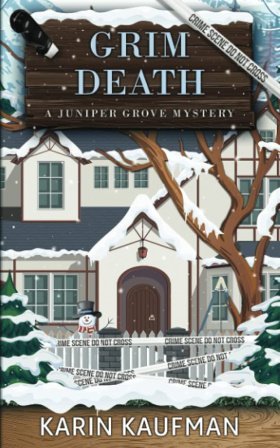“She knew what her payback would be, and so did someone else.”
I pulled out my phone.
“Who are you calling?”
“Mary Blackwell. She owes me.”
“Don’t. Let’s surprise her.” Gilroy pulled from the curb, his tires slipping for half a second before his four-wheel drive took hold.
CHAPTER 20

“Where’s Clay?” Gilroy asked.
“In the back bedroom—his studio,” Mary answered, her eyes positively popping at the sight of both me and Gilroy at her door. “He didn’t do anything.”
“I’m not saying he did,” Gilroy said.
“Are you going to invite us in?” I asked.
“Are you here as police?” she asked. “Both of you?”
“We’re here as friends,” Gilroy said.
I simply glared at her.
Mary swung the door open and gestured, unenthusiastically, for us to enter. “It’s late, you know. And friends? I don’t know about that.”
I could have thwacked her, figuratively. And possibly literally. “That’s on you, not us,” I said, shutting the door behind me. “And if Clay didn’t do anything wrong, and you didn’t do anything wrong, you’ll want to answer our questions. We’re trying to help—something you never did.”
“Clay, it’s Chief Gilroy!” Mary shouted. She took a step back and crossed her arms. The vile Hidden Little Town Number 8, the Laura Painting, was a few feet to her rear.
A moment later Clay appeared. “This is a surprise,” he said, trying his best to smile.
“It’s not a social call,” Gilroy said. “I have two questions. Answer them and I’ll consider not arresting you for obstruction.”
Clay threw his hands up, palms out in supplication. “Whoa, whoa, what’s this about?”
“I know about Dalton Taylor’s forgeries,” Gilroy said.
Clay’s face fell. No, it practically melted and slid from his cheekbones to his chin.
“What forgeries?” Mary asked, her eyebrows drawn in confusion.
“My question is simple. Did Laura Patchett tell you about them or did you discover them on your own?”
“Forgeries?” Mary persisted. “He painted his own garbage, not someone else’s.”
Clay turned to her. “On the side,” he said softly.
“It’s illegal,” Mary said.
I almost laughed. As if she cared about legality. Or morality.
Clay wandered over to his kilim sofa and sank into it. “He did it on the side, to finance his rather lavish lifestyle. He created new, so-called undiscovered works by only marginally known artists. He was greedy, but not overly greedy.”
“Marginally known artists like Jean-Louis Dumont,” Gilroy said.
Clay moaned and ran a hand down the side of his face. “Yes. That painting he gave you as a wedding present. His first Dumont, he said.”
Mary dropped her arms and walked to the sofa, confronting Clay. “Our star gallery artist was a forger?”
Clay glanced briefly at her before staring down at his shoes. “I didn’t know until Laura told me.”
“When was this?” Gilroy asked.
“December twenty-seventh. She said she’d get proof and that I should know. She told me to tell Isak, and I did.”
“Why didn’t she tell Isak?” I asked.
“I think she didn’t feel at ease around him,” he answered. “Not like with me, or mostly with Mary, really.” He looked my way. “Isak was a start, I think. Eventually she would’ve told whoever she needed to tell.”
“Did you tell Isak Karlsen about the forgeries?” Gilroy asked.
“Yeah. That same day. He said, ‘Don’t worry, Laura won’t say anything and we can smooth things over at the brunch.’” He shook his head. “That didn’t work out. Laura saw the painting, and, well, you heard her. Then and there she decided she wanted payback, and she knew how to get it. Dalton had no idea what she was planning to do because he had no idea she knew he was a forger. She told me, but not him.”
The expression on Mary’s face told me she was desperately trying to catch up on the facts. “The painting that made her angry.” She pivoted toward Number 8.

























